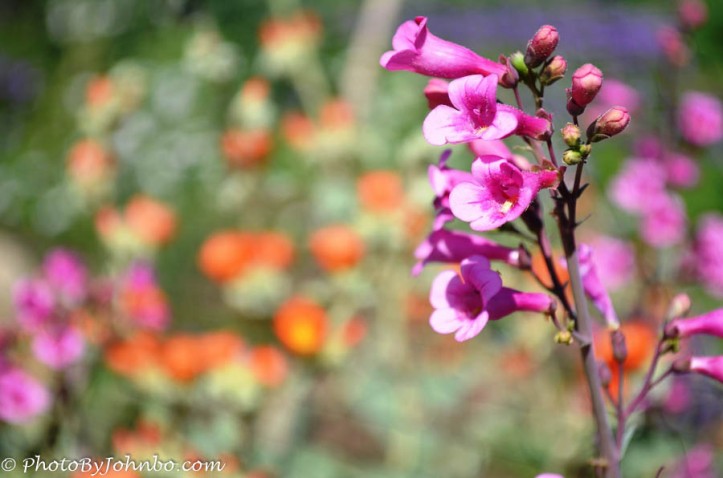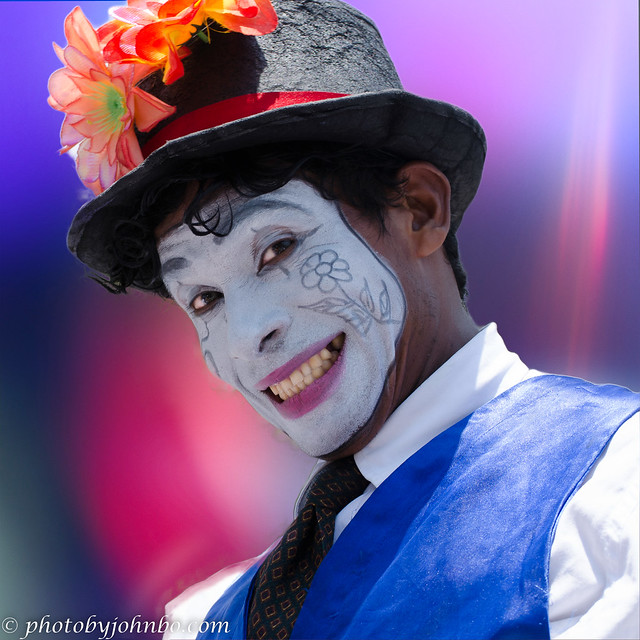
This week, Ritva shares her expertise with a discussion on backgrounds and challenges us to share our own images with an eye toward what is behind the subject. She writes, “This week is a lesson in paying attention to the background BEHIND your subject, does this not sound like a challenge, but it is, if you really start to focus on it. So, think about different techniques you use to elevate your photos and share them with us.” You can read her entire challenge post here.
As Ritva noted in her post, “Utilize depth of field to blur your background, keeping focus on your subject.” That background blur and the rule of thirds helped me create a title slide for a PowerPoint slideshow on desert plants. By shooting close to the main subject, the background flowers blurred, and by allowing the broad background, I had plenty of room to place text to create a title slide. Here’s the image just before adding the title information.
Sometimes, the background can be the subject. At the Oklahoma City Memorial, two gates at either end of a reflecting pond mark the entrance to the memorial. One gate is labeled 9:01, the other 9:03. The reflecting pond marks the single minute between life before and after the 9:02 AM detonation of the bomb that destroyed the Alfred P. Murrah building on April 19, 1995.
On a cruise excursion in 2013, I captured the image of a clown during a fleeting moment when he jumped on the horse-drawn carriage we were riding in. I had no time to even consider the background for the shot, and as it turned out, the background worked out OK. There were some trees, and the bokeh blurred them nicely, but there were also lots of power lines. With improved AI software, programs like Luminar Neo can remove power lines or an image’s background. As an experiment, I removed the background and replaced it with a pattern of lights.
Telephoto lenses help bring the action closer. This shot was captured from my seat in the stands behind first base with a 200 mm f/5.6 setting on the zoom lens. One of the advantages of those expensive f/1.8 lenses is their ability to have a very shallow depth of field. Those lenses are out of my budget. The lens I owned at the time put the crowd in the plane of focus, causing the subjects to blend into the background and make the photo seem cluttered.
Post-processing tools rescued this photo with the application of a blur tool. By judicious application of a Gaussian blur to the background, I could simulate the effect of a much more expensive lens. Compare the two images, and it’s easy to see how that blur makes the subject stand out.
Sometimes, the background can help tell the story in the image. Near Arlington, South Dakota, at the end of a highway, the road turns to gravel as it enters a cemetery. The entrance to the cemetery is beyond the sign, which takes an ironic turn.
Another example of the background helping define the story features this shot of two people concentrating on a clipboard in front of a laundry basket. That alone is enough to imply they are part of the housekeeping staff. The worker in the background and the presses define the area clearly as the laundry.
A few months ago, I had the opportunity to purchase a used Nikon 200-500 mm zoom lens. I took my D500 camera and lens to the zoo to test how well they worked together. The lens works nicely, but my limited choice of background for the shot above tells the viewer I went to the zoo. The chain link fence surrounding the lion’s compound presented no problem for the lens in front of the lion. Focusing on the lion while being so close to the safety fence made the chain link pattern in front of her disappear. However, the links in the background are plainly visible against the out-of-focus sky and trees. This portrait could look more natural with an appropriate post-processing background change.
Another compound in the big cat area provided me a more natural background for this animal portrait. Again, shooting through the chain links directly in front of the lens left no telltale signs of its presence, and the rocks in the background blocked the view of the fence at the back of the compound.
I enjoyed Ritva’s review of the potential of backgrounds to improve an image or enhance the story for this week’s challenge. Her post reminded me of some techniques I could use but have not considered.
Last week, Donna’s challenge reminded us of the value of our connections, both personal and universal. Look for next week’s challenge at noon Saturday EST, hosted by Egidio at Through Brazilian Eyes here. We welcome you to join us with your interpretations. Check here to get started.
John Steiner








That photo of Oklahoma City Memorial Gate is really striking. But funnily enough, in your sports shot, I am more distracted by the blur than by the version which includes the actual spectators. Great animal shots!
Thanks, Margaret. The OKC gates and reflecting pond only begin to tell the story.
Beautiful.
These are great John.
Thanks, VJ!
Welcome
Great examples, John!
I agree with Margaret, that OKC gate is striking.
It’s an emotional monument all the way through.
You’ve covered the topic very comprehensively here John, and done an excellent job of editing that baseball shot! I’ve done similar edits myself and I know how fiddly they can be! I also love the background you’ve chosen for the clown shot, it works really well 🙂
Thanks, Sarah! Editing those backgrounds can be time consuming!
Great post for this challenge. I admire your processing skills and loved the baseball shot. However, I like the original shot with the sharp background. The clown is just amazing, especially with your processing skills. Well done!
Thanks, Anne!
😊
John, this is a great lesson in what to do with the background in our photos. You gave us excellent examples. The post-edits with the clown and players were fantastic!
Thanks, Egidio!
OCM gate sings.
And it is true, the out-of-focus background to the sport shot seems to distract more; perhaps I’m just used to ones in which the background is sharp.
Thanks, I.J. I found that interesting. I will remember next time to leave the background alone. >grin<
John, once again you have nailed the challenge! All of your images are fantastic. Thanks for explaining how you used post processing. The clown is my favorite.
Thanks, Beth. It was an interesting experiment to try different backgrounds behind the clown. This one worked best.
Terrific examples John. The blurring of the baseball background is spot-on, and the edit to the lioness background is better than you think. I couldn’t tell it’s a fence (congrats on the new lens!!). Terrific post
Thanks, Tina! I have some learning to do with it, but I am getting there.
Great images John – particularly like the clown – such a colourful image and the background works so well
Thanks! Fun challenge this week .
So good. As usual. But I like the flowers best, I think. So much summer in one photo!
Summer in the desert, in this case! Thanks!!
Summer in the desert – close 😉 Sometimes a photo conveys a distinct message which is different to real life, in my case I didn’t recognise the flowers so I assumed. 😄
I’m no expert on flowers either. You didn’t suggest where it was originally, only that is was summer. I just noted the location… Coincidentally, we just arrived in Nevada for a family reunion. A fitting place for the first day of summer… well fittingly hot anyway. >grin<
These are all great examples. I le the colors behind the flowers and the edits on the sports photo. The laundry image tells a great story and the big cats are beautiful
Thanks, Nora!
Excellent use of your processing skills for this challenge, John. I love the Oklahoma one and I think both big cats have interesting backgrounds. That looks like a fun lens!
Thanks, Sofia, I’ve taken it birding a couple of times with limited success. Not with poor performance from the lens, but with the lack of skills of the camera person being able to spot birds and get the photos before they disappear. 🙂
It can be tricky, I’m sure. Patience is key 🙂
A great gallery for this prompt, John! The photo of Oklahoma City Memorial Gate is amazing.
Thanks, Aletta. The OKC memorial is a somber museum, and it is effective at sharing the history of that terrible day.
You always work magic with your processing, John – and this post is no exception. Enjoyed also your stories around the photos. My favourite too, is the clown, but all are working so well.
Thanks, Ann-Christine!
Thanks for these an images Anita
Welcome!
I loved this post in totality. You explained each one beautifully.
Thanks, Indira!
You are welcome.